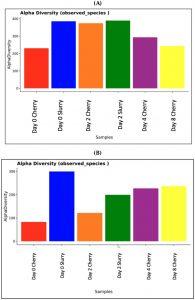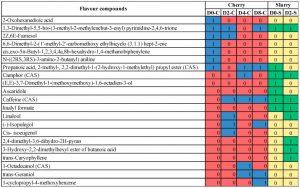The flavour and aroma of coffee are influenced by complex microbial communities that form during fermentation. This study focused on the natural fermentation of Arabica coffee in Thailand, exploring the relationship between microbial diversity and the biochemical characteristics of the final product. Using metagenomic sequencing, the research identified 64 genera of bacteria and 59 genera of yeast and fungi present during the fermentation process, highlighting the importance of yeast and lactic acid bacteria in shaping coffee’s aroma and flavour.
Further Reading: Exploring the link: Gut microbiome and respiratory disease

Figure 1: Figure 4 Alpha diversity was measured for (A) bacterial and (B) fungal and yeast diversity of each sample. The plot indicates the number of observed species in the samples. For analyses without group comparison, a histogram of observed species in each sample is shown.
The wet fermentation process, commonly used for high-quality coffee, facilitates the production of aromatic compounds such as linalool, geraniol, and isopulegol, which contribute to the distinctive flavours of coffee. The microbial communities also produce enzymes, such as pectinase, which aid in breaking down coffee mucilage, improving the fermentation efficiency and flavour profile.

Figure 2: Figure 6 Changes in flavor compounds during fermentation where the number 1 indicates flavors detected in cherry (blue) and slurry (green), while the number 0 indicates flavors that were not detected in cherry (red) and slurry (yellow).
Environmental factors, including temperature and pH, were shown to influence microbial growth during fermentation. As fermentation progressed, the microbial composition shifted, with bacteria dominating the early stages and yeast becoming more prevalent later. This dynamic interaction between microbes and coffee cherries is crucial for developing desirable flavour and aroma compounds.
In conclusion, this study underscores the role of microbial communities in coffee fermentation and their direct impact on coffee quality. By manipulating fermentation conditions and understanding microbial dynamics, producers can enhance the sensory qualities of coffee, leading to more consistent and higher-quality products.
Summary by Faith Oluwamakinde










